Which of the Following Is Not True of the Vietnam Veterans Memorial? Art Quizlet
History of the Vietnam Veterans Memorial
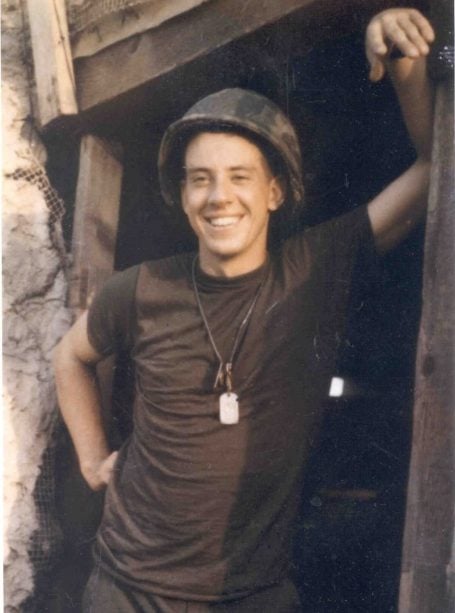
History of the Vietnam Veterans Memorial
The Inspiration
On January 21, 1970, Jan Scruggs was having his morning cup of coffee, but he was far from his kitchen table at dwelling. He was in Vietnam, serving in the 199th Light Infantry Brigade.
In the nine months since he'd been in-country, Scruggs had already seen a lot of action and had been wounded in a battle almost Xuan Loc. He had spent 3 months recovering in a hospital before being sent back to fight with rocket-propelled grenade fragments permanently embedded in his body.
On that Jan 24-hour interval, "At that place was a big explosion," Scruggs recalled. "I ran over to see a truck on fire and a dozen of my friends dying." They had been unloading an armament truck when the explosion occurred. Scruggs would never forget the awful scene. He would never forget those friends.
In fact, he would spend a lifetime trying to honor their memory.
Learn more about Jan Scruggs
History of the Vietnam Veterans Memorial
The Vision
Scruggs was raised in a rural Maryland boondocks between Baltimore and Washington, D.C. His mother was a waitress; his begetter a milkman. "We're all the effect of our upbringing. My background was relatively modest," he said. "But I was e'er impressed with the example my parents gear up."
When the 18-year-old Scruggs volunteered to enlist in the Army in 1968, debate surrounding Vietnam was escalating. The war's length and the growing number of casualties were fueling tensions. Within months later he recovered from his wounds and returned to his unit, the American public was learning the details of the events at My Lai. By the fourth dimension he returned home, three months subsequently the explosion, the state was even further divided.
Over the next few years, as the war came to a close and more and more troops returned home, the media began to paint a picture of the stereotypical Vietnam veteran: drug addicted, bitter, discontented, and unable to suit to life back domicile. Like all stereotypes, this ane was unfair.
The truth was, veterans were no more probable to exist addicted to drugs than those who did not serve. And if they were bitter, who could blame them? When they returned home from serving their country, in that location was no national show of gratitude. They were either ignored or shouted at and called vicious names. Veterans frequently found themselves denying their fourth dimension in Vietnam, never mentioning their service to new friends and acquaintances for fear of the reactions it might elicit.
By June 1977, Scruggs was attention graduate school at American University in Washington, D.C. and had embarked on a research study exploring the social and psychological consequences of Vietnam military duties. He constitute that returning veterans were finding it difficult to trust people. They were feeling alienated from the nation'due south leaders, and they had low self-esteem. He likewise found that those veterans whose units experienced high casualty rates were experiencing higher divorce rates and a greater frequency of combat-related dreams. Using his findings, he testified at the Senate hearing on the Veteran's Health Care Amendments Act of 1977, with the hope that he could assist veterans gain admission to the services and back up they needed.
He also wanted to notice a style to help them heal and suggested that the country build a national memorial as a symbol that the country cared nearly them.
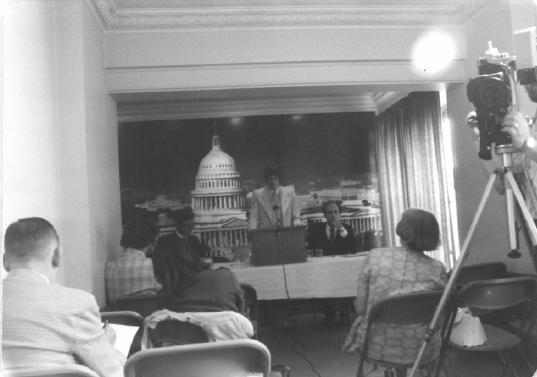
By 1979, the state was get-go to accept more positive feelings toward Vietnam veterans. Movies were dealing more realistically with their issues. And Congress had declared a "Vietnam Veterans Week" for that April to honor those who had returned home.
One picture show that came out early on that twelvemonth,The Deer Hunter, explored the furnishings of state of war on three friends, their families and a tight-knit customs. When Scruggs went to come across the movie in early 1979, information technology wasn't the graphic state of war scenes that haunted him. It was the reminder that the men who died in Vietnam all had faces and names, too every bit friends and families who loved them dearly. He could notwithstanding picture the faces of his 12 buddies, but the passing years were making it harder and harder to remember their names.
That bothered him. It seemed unconscionable that he–or anyone else–should be allowed to forget. For weeks, he obsessed about the idea of building a memorial.
"It just resonated," he explained. "If all of the names could exist in one place, these names would have great power—a ability to heal. It would have power for private veterans, but collectively, they would have even greater power to prove the enormity of the sacrifices that were made."
His research had proven that mail service-traumatic stress was real and had shone a calorie-free on the challenges faced by a significant number of military veterans. The idea for a memorial seemed like a natural extension of his work and his growing desire to find a mode to help veterans. He had studied the piece of work of psychiatrist Carl Jung, a pupil of Sigmund Freud, who wrote of shared societal values. Equally Scruggs analyzed the concept of collective psychological states, he realized that, just as veterans needed psychological healing, so also did the nation.
"The Memorial had several purposes," he explained. "It would aid veterans heal. Its mere being would exist societal recognition that their sacrifices were honorable rather than dishonorable. Veterans needed this, and then did the nation. Our country needed something symbolic to help heal our wounds."
History of the Vietnam Veterans Memorial
Building Support
Once Scruggs decided to build the memorial, the side by side step was to get some people behind him. An ad hoc group of veterans had scheduled a meeting to try to utilise Vietnam Veterans Week to generate publicity for veterans' demand, and Scruggs thought that would be a good time to announce his plans.
But instead of enthusiasm, he received skepticism. Virtually at the meeting told him they didn't desire a memorial; they wanted more benefits and government back up. But the coming together gave Scruggs his first ally: former Air Force intelligence officeholder and chaser Robert Doubek, who idea a memorial was a practiced thought.
"When I was attention law school, Vietnam veterans were an anomaly among the young unmarried professional set of Washington, so it was something you didn't mention." remembered Doubek. "It seemed unfair and inappropriate that there should be no recognition."
Doubek approached Scruggs after the meeting and suggested that he form a nonprofit corporation as a vehicle to build a memorial. On Apr 27, 1979, Doubek incorporated the fledgling entity, the Vietnam Veterans Memorial Fund, and Scruggs asked him to be an officer and director.
To brand his dream a reality, he planned to get support from people as diverse as former anti-state of war presidential candidate George McGovern and Gen. William Westmoreland, who commanded U.S. forces in Vietnam. Scruggs took two weeks off from his job at the Department of Labor to develop the idea further.
Scruggs and Doubek began having regular meetings with John P. Wheeler, a graduate of Due west Point and Harvard Business organization School. Wheeler recruited others to assist, starting with a grouping of professional person men, all Vietnam or Vietnam-era veterans: George "Sandy" Mayo, Arthur Mosley, John Morrison, Paul Haaga, Bill Marr, John Forest and certified public accountant Bob Frank, who agreed to become VVMF's treasurer. Paul Haaga's spouse, Heather Sturt Haaga, soon came forward to lend her experience in fund raising. William Jayne, who had been wounded in Vietnam, volunteered to head upwards public relations activities.
The greatest challenge VVMF faced, said Doubek, was "to put together a functioning organization with people who didn't know one another, people who were very immature and didn't take a lot of experience. We had to constantly find the most effective next footstep to take and be certain non to get waylaid by tangents." The grouping started to hold regular planning meetings
For Forest, the growing coalition was a prime number example of "it'southward not what you know, it'south who you know." These people, though a small group, were able to accomplish out to their networks and their extensive contacts to recruit the type of expertise and support required for such a mammoth initiative. Their military experience meant they had contacts far and wide, at all levels of all professions, within government and the private sector. It seemed every time they contacted someone, they were greeted with enthusiasm for the thought. Everyone wanted to join the endeavor. And if they themselves didn't know how to help, they knew someone who did.
Their initial timeline was aggressive, with an ultimate goal of dedicating the Memorial on Veterans 24-hour interval 1982—just a little more than 36 months away. The listing of tasks to achieve such a goal seemed countless. They needed to secure a plot of land, enhance funds and public awareness, design the Memorial, coordinate construction, and organize the dedication ceremonies. Most importantly, they needed to navigate the channels of government authorizations and approvals.
Never in the history of the United States had a national memorial been conceived, approved, congenital and dedicated in that short an corporeality of time. But if the challenges seemed insurmountable, no one expressed any fears. And none of them discussed their ain personal feelings or political views regarding the war. All of them realized how critical it was that a memorial be apolitical. They prepare their sights in support of the clear, unproblematic vision Scruggs outlined:to laurels the warrior and not the war.
History of the Vietnam Veterans Memorial
The Congressional Mandate
The VVMF organizers presently learned that it required an Act of Congress to build a memorial on Federal land, and Scruggs first called 1 of the senators for his home country of Maryland. Charles "Mac" Mathias, a Navy veteran of World State of war II, had been opposed to the war in Vietnam, just he had ever respected those who served in it.
Mathias set up a meeting so he could learn more than. "I had my ear to the ground," Mathias recalled. "I heard in that location was a grouping of serious veterans, non just people getting together to take a beer in the evening, just a grouping that was serious virtually getting together to address the issues of the veterans."
Mathias had grown increasingly concerned about how veterans had been treated on their render. Because he possessed keen knowledge of history, he understood the extensive healing procedure required after war. A memorial made perfect sense to him. It would be a way to honour the veterans and to help them—and the state—heal.
"Initially the (Senator'southward) staff was split," recalled Monica Healy, a long-fourth dimension Mathias adjutant, "on whether Mathias should take the pb and back up the efforts to build the Memorial. The senior staffers were confronting it. It was the Senator'due south gut feeling that we needed to practice this."
"This was serious business," Mathias said. "You lot had to live through that period to really understand it. . . Merely the veterans had real problems. They needed support, friendship and assist. And that bulletin got through to me."
Mathias also knew the land was ready, Healy recalled. Timing is everything, and enough fourth dimension had passed. Intellectually and emotionally, America could embrace the thought.
Scruggs and Doubek met with Mathias to outline their plans. They stressed that all funds for the Memorial would exist raised from private donations. No government funds would exist necessary. What they did demand, notwithstanding, was an acceptable location for the Memorial and enough back up to push the idea through various governmental committees and agencies.
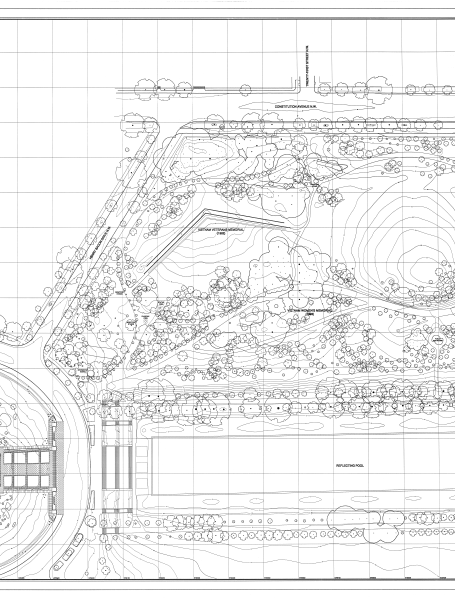
History of the Vietnam Veterans Memorial
The site and the legislation
I of Mathias' early key suggestions was that the memorial should be on the Mall, especially because the anti-war demonstrations had taken place there. Wheeler had the thought to bypass the traditional site selection route and take Congress pass legislation to award a specific area for a memorial site. Scruggs, Wheeler, and Doubek then scouted the Mall – sometimes by bicycle – to identify the ideal spot: a stretch of parkland known as Constitution Gardens, located on the National Mall adjacent to the Lincoln Memorial.
Among other duties, Healy was the member of Mathias' staff who handled memorials and worked as the liaison with the U.S. Department of the Interior. Because of this, Mathias appointed her to manage the details and to piece of work with Scruggs, Doubek, and Wheeler on the legislation for the memorial. "The three of them had dissimilar strengths," Healy explained. "Jan was a great spokesperson. Bob was the detail person and a good writer. Jack was the visionary, the creative, big-picture guy. They really worked well together and were the driving force. It was such a great cause, and they were spring and determined to make it happen."
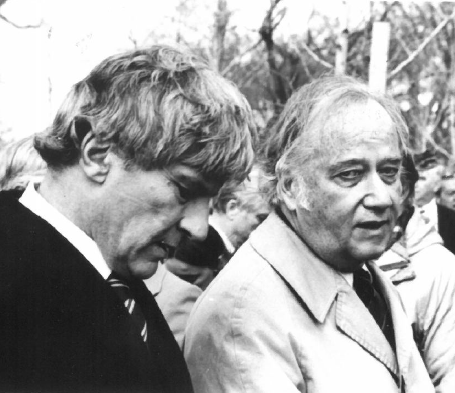
History of the Vietnam Veterans Memorial
Enlisting Senator John Warner
As they forged a partnership with Mathias and his staff, VVMF also fix out to establish other central relationships. Scruggs took a bold step in contacting Virginia Senator John Warner. Warner, who had served as Secretary of the Navy during the war, was himself a veteran of World War 2 and the Korean War. Later on meeting with the VVMF officers and advisors, Warner volunteered to help the system raise the seed money needed to launch the fund raising campaign.
Because Warner was from Virginia and Mathias from Maryland, the two had worked together on many regional issues. "We had been friends for a long fourth dimension," Mathias said. "He was an excellent partner and fundraiser." Mathias knew the legislative process. Warner, at the fourth dimension married to Elizabeth Taylor, had potent connections to both Hollywood and the corporate world.
On Nov viii, 1979, VVMF held a printing briefing in which Mathias, Warner, and several others announced the introduction of legislation to grant two acres of country near the Lincoln Memorial for the Vietnam Veterans Memorial.
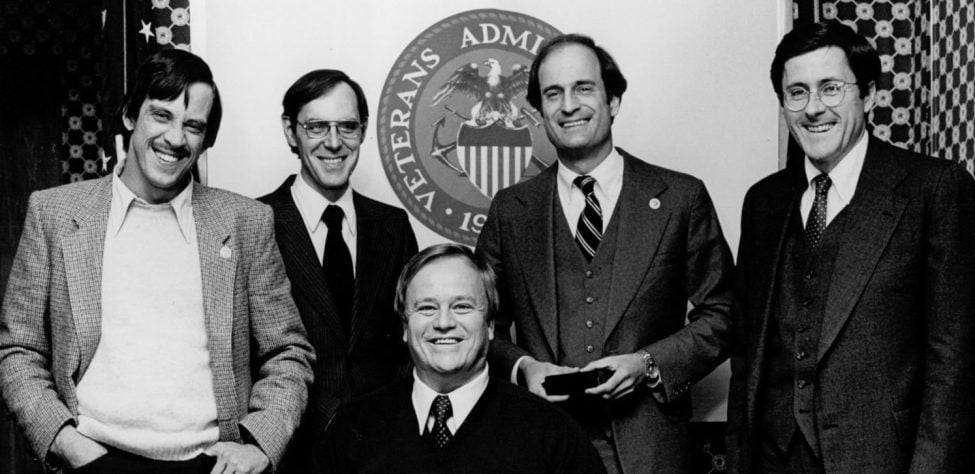
With the introduction of legislation, the VVMF leaders realized that information technology was time to transition from a volunteer committee and to open a staffed office. In December Doubek became the Executive Director, working on a half-time footing for the get-go few months, and opened the VVMF office on January 2, 1980. He organized the advisors and volunteers into task groups: public relations, financial management, fund raising, legislation, site selection, and design/structure. The priorities were to launch fund raising and achieve passage of the authorizing legislation.
The task groups proved effective, as described by John Forest, who jointed every bit a key advisor. He cited the growing coalition was a prime number example of "it's not what you know, information technology's who y'all know." These people, though a pocket-sized grouping, were able to attain out to their networks and their all-encompassing contacts to recruit the blazon of expertise and support required for such a mammoth initiative. Their military machine experience meant they had contacts far and wide, at all levels of all professions, inside government and the private sector. Information technology seemed every time they contacted someone, they were greeted with enthusiasm for the idea. Everyone wanted to join the effort. And if they themselves didn't know how to help, they knew someone who did.
Afterwards working lone for six months, Doubek was joined on the staff by Kathy Kielich, who served as the Office Manager throughout the project.
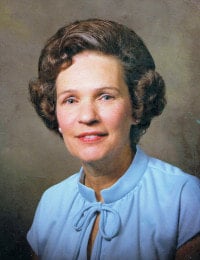
History of the Vietnam Veterans Memorial
Teaming up with the families
Early in his efforts Scruggs had called on Emogene Cupp, then the national president of the American Gold Star Mothers. "Jan came to our headquarters to come across if nosotros had any room to assist them go started," Cupp remembered. "Nosotros didn't take any space, merely I liked their idea and told them I would volunteer to help with all that I could."
The Gold Star Mothers is a group of mothers whose sons or daughters have died serving their country. Their motto is: "Honor the dead by serving the living." Volunteering to assistance VVMF was an platonic opportunity for Cupp to do just that.
Cupp had experienced firsthand the pains caused past the state of war. Her merely son Robert, an Army draftee, was killed by a land mine on his 21st birthday, June 6, 1968. Compounding the pain was that society'due south ill handling of the veterans extended to their families. "Information technology was very hurtful," Cupp recalled. "They treated the moms the same equally they treated the vets. They weren't nice. At that time, they just ignored you and wished you would go abroad. Or, people would tell me, 'Well why did you let him go?' Of grade, what choice do you have?"
Scruggs and Doubek realized that Cupp could exist instrumental in helping communicate the earth-shaking personal, emotional side of the healing story. Cupp attended many of their meetings on Capitol Hill as they drummed up support.
History of the Vietnam Veterans Memorial Fund
Funding the Effort
Just before Christmas 1979, Warner hosted a fundraising breakfast in his Georgetown home. He fabricated an impassioned plea for funding to his guests, members of the defense force manufacture. Before he spoke, withal, all eyes had turned toward the kitchen door, from which has emerged his then-wife, extra Elizabeth Taylor. She greeted each company in a regal fashion, wearing a dressing gown, perfect makeup, and beautiful shoes that curled upwardly at the toes. "I'm sure I looked like a deer in the headlights, I was so nervous," Scruggs recalled. "I think I even spilled my coffee." But, her presence made a difference. "I heard that those present agreed to double their contributions after Taylor completed her remarks," Scruggs said.
With the seed money from several defense industry donors, particularly Grumman Aerospace, VVMF launched its first large-scale direct mail service campaign to reach out to the public. To created brownie for the fledgling effort, they formed the National Sponsoring Committee, which included then-start lady Rosalynn Carter, onetime President Gerald Ford, Bob Hope, future first lady Nancy Reagan, Gen. William C. Westmoreland, USA, Vietnam veteran author James Webb, and Adm. James J. Stockdale, USN.
The first fundraising letter was signed by Bob Hope. It echoed the theme that regardless of how anyone felt about the war itself, everyone cared nigh honoring the men and women who had served and those who had ultimately lost their lives.
By early 1980, contributions started to make it. Millionaire H. Ross Perot made a sizeable donation.
Direct mail service was proving to exist a highly effective fundraising tool. Letters came from moms, dads, grandparents, sons and daughters with heartfelt notes accompanied by checks and dollar bills. They came from veterans and from the neighbors, teachers, coaches and friends of veterans. The public wanted to have a hand in helping to build the Memorial and in honoring the warrior, not the state of war.
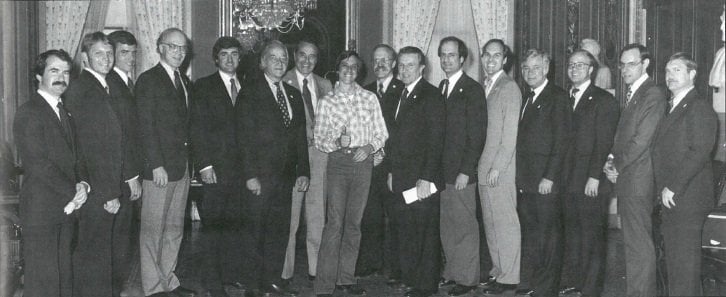
As VVMF focused on fundraising, Sens. Mathias and Warner connected to rally support and ferry the legislation. Mathias and Warner continually stressed that their objective was to provide the state with a symbol for reconciliation.
"At that place were so many people helping to get the legislation [passed]," remembered Healy. "The more people you lot got to co-sponsor, the more people wanted to join."
On Apr 30, 1980, the Senate canonical legislation authorizing the Memorial, followed by approval in the Business firm on May twenty, 1980. Although differences in the two bills required a Conference Committee to run across, on July i, at a White House Rose Garden anniversary, President Jimmy Carter signed legislation providing two acres for the Vietnam Veterans Memorial on the National Mall.
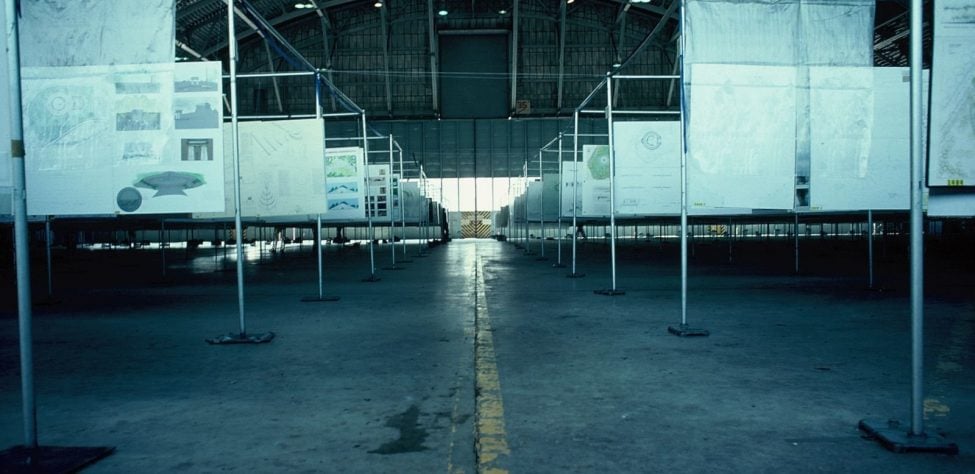
With the site approved, VVMF scrambled to address the problems of what the Memorial would expect similar and who would blueprint information technology. A few preliminary concepts were embraced. As Scruggs had always envisioned, the Memorial would characteristic all of the names of those who had died. Wheeler suggested that information technology should be a landscaped solution: a peaceful, park-similar setting that could be harmoniously with the Washington Monument and the Lincoln Memorial.
They were also keenly aware that the legislation made the Memorial's design subject to the approval of the Commission of Fine Arts (CFA), the National Uppercase Planning Commission (NCPC), and the Secretary of the Interior.
It was decided that VVMF would hold a blueprint contest, open to any American denizen over 18 years of age. Just as the American people could be a part of edifice the Memorial through their contributions and support, they could also have an opportunity to participate in its blueprint.
Equally a beginning step, VVMF retained architect Paul Spreiregen to serve as the Professional Advisor for the contest. Spreiregen, a graduate of the MIT School of Architecture and Planning, was a Fulbright Scholar who had served as the director of urban blueprint programs at the American Institute of Architects (AIA) from 1962-66 and as the get-go manager of compages programs at the National Endowment for the Arts from 1966-70. An writer, teacher, and lecturer, Spreiregen had written the authoritative book on design competitions.
At the fourth dimension, well-managed open design competitions were mutual in Europe, but not in the United states of america. Most, similar the Lincoln Memorial, were competitions betwixt select designers. But a few, such every bit the St. Louis Gateway Arch, role of the Jefferson National Expansion Memorial, had been the result of open up competitions.
Spreiregen wrote, "I saw this as a needed opportunity to honor the service and lives of the soldiers we had lost and practice so by running a model contest."
Arthur Mosley headed the site selection job group and was assisted by John Wood, a structural engineer, who had been permanently disabled in a helicopter crash in Vietnam. (Woods continues to serve on VVMF'southward Board of Directors to this day.)
For three solid months, Spreiregen, Mosley, Forest, and Doubek planned the competition. "We had to build credibility among the pattern community, but also build credibility with the veterans," said Forest. "The pattern contest likewise needed to exist able to attract pattern competitors."
There were 4 phases to the design competition spanning nearly one yr: planning and preparation; the launch; the design phase; the design evaluation and choice; the press conference and public presentation. The selected design so had to get through Federal agency approval and development into finished plans.
"The kickoff phase encompassed the item planning and preparations for holding the competition," said Spreiregen. "Holding a competition is similar launching a rocket. Everything has to be idea out and in place before the launch button is pressed."
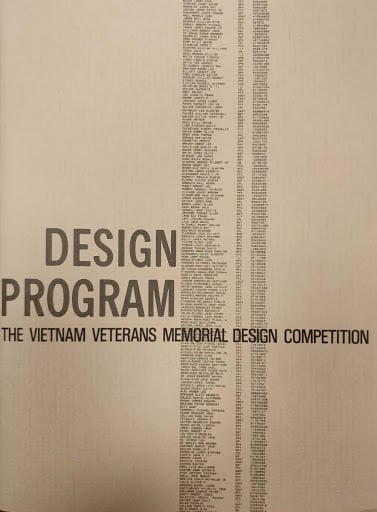
History of the Vietnam Veterans Memorial
The design criteria
The purpose of the Vietnam Veterans Memorial was to honor all who had served, with a special tribute – their names engraved – for those who did not return. The principal design criteria were that the memorial be 1) cogitating and contemplative in graphic symbol; two) be harmonious with its site and environment, 3) make no political statement about the war itself, and 4) contain the names of all who died or remained missing. "The hope is that the creation of the Memorial will begin a healing process," Doubek wrote.
Healing meant many things to many people. Could a memorial accomplish such an enormous and daunting task? Could it heal the chasm inside society, promote closure, evidence gratitude to those who served, comfort those in grief, and remind future generations of the toll wrought past war? Moreover, could information technology reach all of that while listing the approximately 58,000 names in an artistic, meaningful way?
History of the Vietnam Veterans Memorial
Selecting the jury
Selecting a blueprint that would meet the criteria demanded a jury that could grasp the significance of the Memorial's purpose and understand the unique needs of Vietnam veterans, their families, and a country divided.
For weeks, heated discussions took place effectually the topic of who should be part of the design jury. Many felt information technology should be composed primarily of veterans; others felt it should be made upward merely of professionals; some idea a mix of the ii would be best.
Ultimately, the VVMF Board agreed on a jury of the near experienced and prestigious artists and designers that could be found, since it took a mature eye to envision from two-dimensional renderings how a design would look when congenital. The reputation of the jurors was important to attract the best designers and to minimize 2nd guessing past the Federal approval bodies
Spreiregen recommended having a multi-disciplinary panel: two architects, ii mural architects, two sculptors, and 1 generalist with extensive knowledge most art, architecture, and design. VVMF met the prospective jurors and scrutinized their credentials. "They constitute that they were very real people who did many of the same things they did," recalled Spreiregen. "They were real guys. The VVMF group liked them all and approved of them with trust and enthusiasm," even selecting 3 sculptors, making a total of eight jurors.
The jury included: architects Pietro Belluschi and Harry Weese; landscape architects Hideo Sasaki and Garrett Eckbo; sculptors Costantino Nivola, Richard Hunt, and James Rosati; and Grady Clay, a journalist and editor of Mural Compages magazine. Four of the eight were themselves veterans of previous wars.
Each juror was required to read Fields of Fire, A Rumor of War, and other electric current literature almost the Vietnam War. "Many had worked together, some in Washington. They were also the most collegial people, who would deliberate intensely but never argue or posture," Spreiregen remembered.
History of the Vietnam Veterans Memorial
Launching the competition
With the jury selected, the side by side chore was to denote and promote the competition. In the fall of 1980, VVMF appear the national design competition open to whatever U.Due south. citizen, who was over 18 years old.
Past year's cease, ii,573 individuals and teams had registered – almost iii,800 people in total. From the registration forms, it was apparent that architects, artists, designers, likewise every bit veterans and students — of all ages and all levels of experience — were planning to participate. They came from all parts of the country and represented every country. By the March 31, 1981, deadline, i,421 design entries were submitted for judging.
With such an overwhelming response to the contest, logistics became an outcome. Finish-to-end, the total number of submissions would have stretched ane and 1 tertiary linear miles. Each submittal had to exist hung at heart level for review by the jury. Merely how and where could all of the submissions be displayed?
Vietnam veteran Joseph Zengerle, then an Assistant Secretarial assistant of the Air Force, volunteered the utilise of an aircraft hangar at Andrews Air Forcefulness Base of operations. The added component of war machine security fabricated the location even more bonny, since it would ensure no interference with the designs or the judging.
In accord with the strict competition guidelines, anonymity of all designs was carefully observed. Each contestant sealed his or her name in an envelope and taped it to the back of the submission. The designs were received and candy in a large warehouse east of Washington. They were unwrapped, number coded, photographed for the record, and prepared for display.
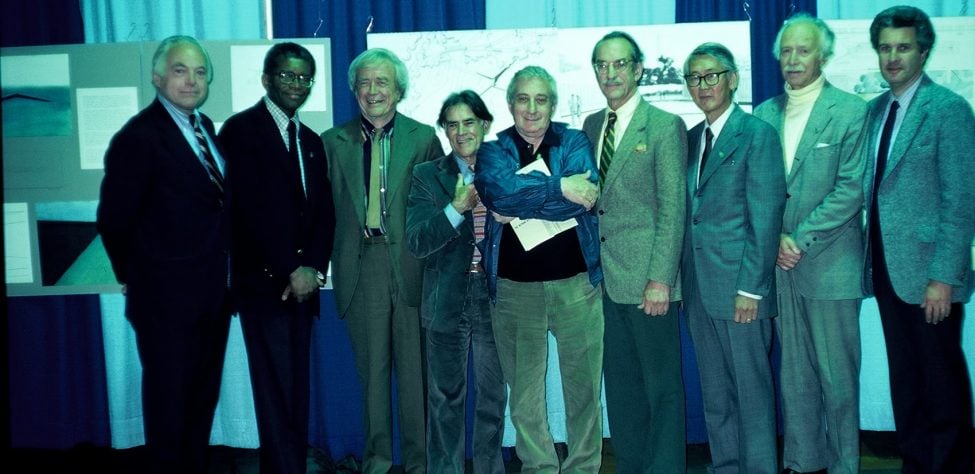
The jury evaluation took place over 5 days, from Apr 27 through May one, 1981. The jurors began by touring the site and and so returned to Hangar #3 at Andrews to view each of the 1,421 designs individually.
"I had calculated that it was possible to see all of them in a minimum of 3 1/2 hours. The eldest juror, Pietro Belluschi, took a full day," said Spreiregen. "By the end of the beginning afternoon, 1 of the jurors, Harry Weese, returned to our impromptu conference lounge and told me, 'Paul, in that location are two designs out there that could practise information technology.'
"On the second day, the jury examined the designs together, walking the many aisles and stopping at each of the 232 designs that had been flagged by ane or more of the jurors, pausing to discuss each blueprint that had been noted. The first cut was further reduced to ninety by midday Wed. By Thursday morning time, it was down to 39. That afternoon, the winning blueprint was selected," said Spreiregen.
"It was the most thoughtful and thorough discussion of pattern that I take always heard, and I have heard many," he recalled.
With the winning blueprint in hand, Spreiregen had less than 24 hours to arts and crafts an explanation of the decision—and the blueprint—that would be suitable for presentation to VVMF.
Throughout the judging process, one of the judges, Grady Clay, had taken meticulous notes of the jury'due south discussions. Together with Spreiregen, he composed a report based on these thoughtful comments.
"They are a treasure of blueprint insight and included many prescient thoughts as to how the Memorial would likely be experienced," Spreiregen wrote of Clay'south notes.
Some of the juror comments included:
"Many people volition not encompass this blueprint until they experience it."
"It will be a better memorial if it's non entirely understood at outset."
"Confused times need simple forms."
According to the description of the design concept: "The jury chose a design which will stimulate thought rather than contain it."
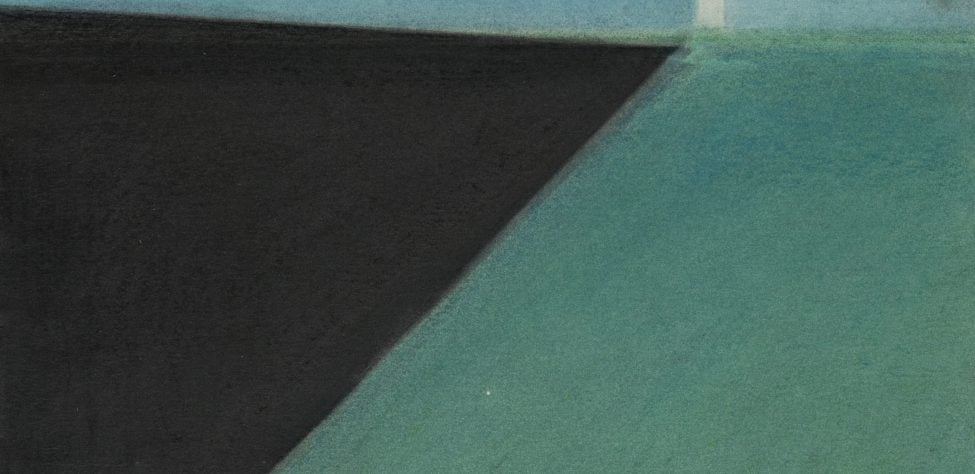
The winning design was the work of Maya Ying Lin of Athens, Ohio, a 21-twelvemonth-old senior at Yale University. At 21 and still an undergraduate, Lin conceived her design equally creating a park within a park — a quiet protected place unto itself, even so harmonious with the overall plan of Constitution Gardens. To achieve this effect she chose polished black granite for the walls. Its mirror-similar surface reflects the images of the surrounding trees, lawns and monuments. The Memorial'due south walls point to the Washington Monument and Lincoln Memorial, thus bringing the Memorial into the historical context of our country. The names are inscribed in the chronological order of their dates of casualty, showing the war as a series of individual human sacrifices and giving each name a special place in history.
In August of 1981, VVMF selected a building visitor and architecture firm to develop the plans and build Lin's blueprint. Lin became a design consultant to the architect of record.
Learn more near Maya Lin
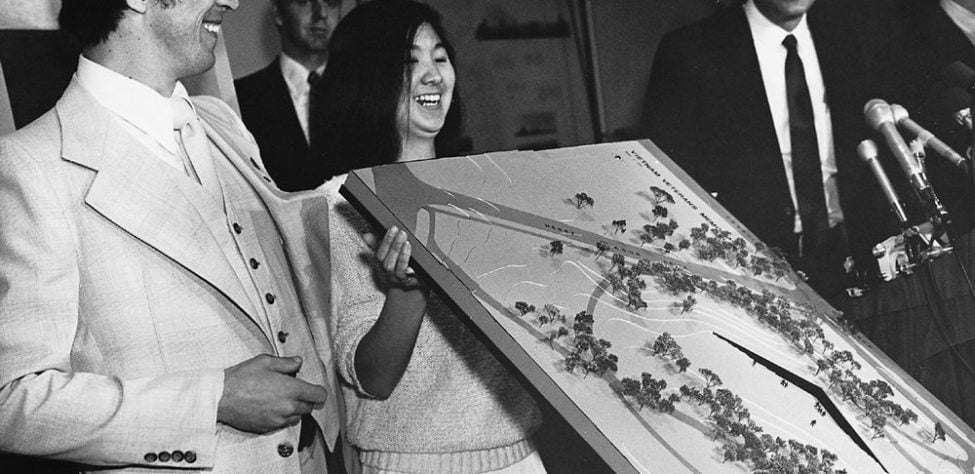
Early in the effort to get the Memorial built, there were traces of controversy. Some felt that the money to build a memorial could be better spent delivering the many services veterans needed. Others questioned the intent of the Memorial.
When VVMF announced the selection of Lin's design, the initial public reaction was generally positive.
Simply several weeks afterwards the announcement, a handful of people began to protest the design. A few of the most vocal opponents, including James Webb and H. Ross Perot, had previously been strong supporters of a memorial. They complained about the walls beingness black. They did non similar the thought that information technology was below ground level. They did non like its minimalist pattern. They felt it was a slap in the face to those who had served considering information technology did not incorporate traditional symbols honoring service, backbone, and sacrifice. Some opponents only did not like the fact that Lin was a young student, a woman, and of Asian descent; how in the world could she maybe know how to accolade the service of the Vietnam veteran?
Then, in Oct 1980, veteran and lawyer Tom Carhart, also a former supporter, testified before the Committee of Fine Arts (CFA) against the design, saying that "I needs no artistic pedagogy to run into this design for what information technology is, a black trench that scars the Mall. Black walls, the universal color of shame and sorrow and degradation."
Lin moved to Washington and immediately became role of an internal struggle for control of the pattern. To bring the design into reality would require an architect of record. Lin and VVMF somewhen selected the Cooper-Lecky Partnership as the architect-of-tape, with Lin equally the projection's pattern consultant.
A compromise
By early on 1982, VVMF asked Warner to bring together both sides for a closed-door session to hammer out the issues.
An article by Hugh Sidey in the February 22, 1982, issue ofTime magazine described the session: "A few days ago, 40 supporters and critics of the memorial gathered to try to pause the impasse that threatened the memorial because of such features as the black colour of the rock and its position below footing level. Later on listening for a while, Brigadier General George Toll, a retired veteran of Korea and Vietnam, stood in quiet rage and said, 'I am ill and tired of calling black a colour of shame.' General Cost, one of America's highest-ranking black officers lived with and advised the 1st Vietnamese Infantry Segmentation.
To Heal a Nation, a volume written by Jan Scruggs and Joel Swerdlow about the creation of the Memorial, provides a vivid sketch of the scene:
"'I accept heard your arguments,'" said General Price. 'I remind all of you of Martin Luther Male monarch Jr., who fought for justice for all Americans. Black is non a color of shame. I am tired of hearing it called such by y'all. Colour meant nothing on the battlefields of Korea and Vietnam. Nosotros are all equal in combat. Color should hateful nothing at present.'"
Sidey's piece continued: "At the end of v hours and much shouting, General Mike Davison, retired, who led the Cambodian incursion in 1970, proposed a compromise: add the figure of a soldier in front end of the long granite walls that will comport the 57,709 names of those who died or are missing and the tribute to all who served. The battle was suddenly over."
A new obstacle
VVMF agreed to the statue compromise, likewise as to adding a flag and to reviewing the inscription on the Memorial, just they did non want to look until a statue was designed before breaking ground. Waiting meant they would never reach their dedication borderline of Nov eleven, 1982.
Over several tense weeks, more debate followed, until the Commission of Fine Arts (CFA) and the National Capital Planning Commission (NCPC) gave their approving for a statue and flag in concept, awaiting suitable placement of those elements. Watt followed on March 11, 1982, by granting permission for the structure permits.
With permit in paw, Doubek instructed to embark construction immediately. His reasoning was that a consummate mess would make it tough to finish construction. Scruggs added: "Make this place await like an airstrike was called in," he instructed. "Rip it apart."
An official groundbreaking ceremony was held on March 26, 1982. Full general Cost, forth with Senators Warner and Mathias and future Secretarial assistant of Defense Chuck Hagel, gave moving addresses before the control was given, and 150 shovels entered the ground with enthusiastic veterans enjoying the moment.
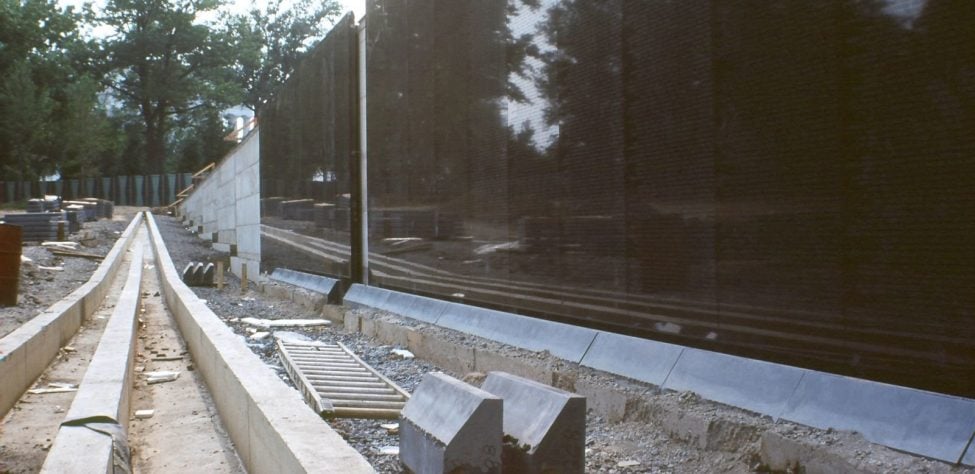
As presently every bit the design was chosen, the next pace was to consider the all-important details of getting it built.
Maya Lin worked closely with Cooper-Lecky on all aesthetic aspects of the blueprint. Lin knew information technology was critical to maintain the simplicity of the design throughout the design development and structure process.
Choosing the granite
As the selection of the granite was narrowed down, Lin was great on preserving the notion that the granite walls exist reflective and thin – to aid express a critical attribute of the design – that the memorial was a cutting in the earth that had been polished.
Working with the structure manager, Gilbane Building Visitor, the design team had to locate the appropriate type of granite: a flawless, reflective, deep ebony stone. In the end, the quarry in India was selected.
Finalizing the size
The selection of the lettering style – Optima, designed past Hermann Zapf – was a font Lin selected afterward considering a multitude of options.The font Optima seemed to fit that desire to match an almost printed quality with a hand-cut feel.
The entire text size and layout Lin saw as an open up book.
The text size is less than half an inch, which is unusual for monument blueprint, merely was selected to make the memorial read more similar a book. This lends a sense of personal intimacy in a public space which helps create a sense of connection to the memorial.
Ultimately, one of the greatest challenges was how to get that many names on the wall panels in such a short menses of time.
Inscribing the names
The design Lin envisioned listed the names chronologically by engagement of casualty. Still, that posed a trouble of how to locate an individual proper noun. When Lin asked how many Smiths would be on The Wall, the squad realized how important the chronological listing was to the pattern.
A chronological list would too allow a returning veteran to discover his or her time of service on The Wall and those who died together to remain together forever on The Wall. The solution on how to locate a proper name evolved into a directory of names with an alphabetical list and the panel and line number of each name.
The families of service members who were missing in activity originally wanted their names listed separately. Ms Lin arrived at a design solution to note those that were MIA with a symbol (†) that could be altered if the service member was plant.
The original pattern proposal chosen for all of the names to be individually hand-chiseled in the stone, but it was shortly realized the fourth dimension and money it would take to practice that were impractical. Instead, Lin found John Benson, a master stonecutter, to hand cut the text at the apex – the years of the earliest and latest casualties from the Department of Defence list and the brief prologue and epilogue side by side to the dates. The design team and VVMF searched for a way for the names to be sandblasted rather than hand-carved.
Larry Century, a young inventor from Cleveland, Ohio, was selected to serve as a consultant to Binswanger Drinking glass Company in Memphis, Tennessee, which was awarded the contract for inscribing the names.
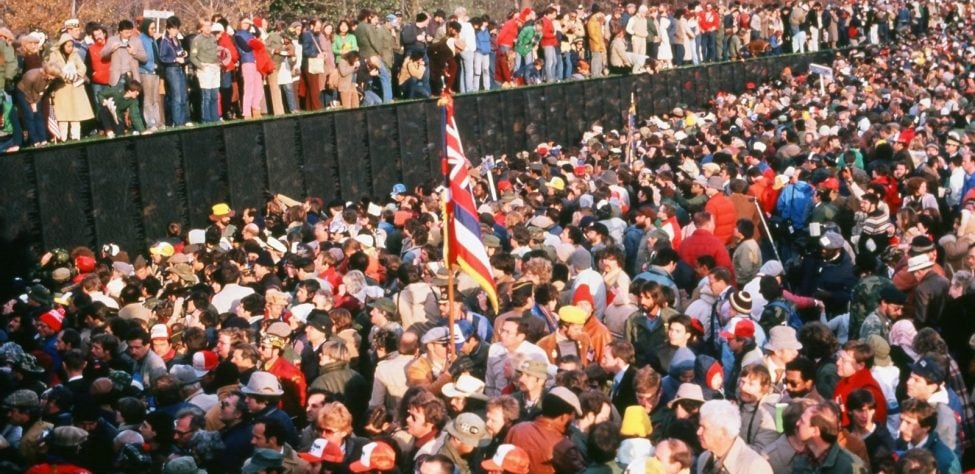
Crowd at the dedication of the Vietnam Veterans Memorial, 1982. Photograph by William "Neb" Lecky
As soon equally ground was broken for The Wall in March 1982, planning for its dedication ceremonies began. They would include a big National Salute to Vietnam Veterans at Veterans Twenty-four hour period. The American Legion, VFW, Disabled American Veterans (DAV), AMVETS, and Paralyzed Veterans of America (PVA) fabricated sure their members knew that veterans were going to be honored and welcomed that calendar week on the National Mall. More than than 150,000 veterans, families, loved ones and friends made plans to attend.
The series of events began on Wed, November 10, 1982, and culminated with a service at the National Cathedral on Sunday, November14.
The Salute opened with a vigil Wednesday morning at the National Cathedral, where all of the near 58,000 names on The Wall were read past volunteers effectually the clock, day and night, through midnight Fri. Every xv minutes, there was a pause for prayer.
On Saturday, a grand parade took place where veterans marched joyously out of sync, some hand-in-manus or with their artillery draped around one some other, holding banners, flags, and signs. Many pushed friends in wheelchairs. The following week, Kurt Anderson recapped the festivities for TIME mag: "Sat's three-hr parade down Constitution Avenue, led by [Gen. William] Westmoreland, was the vets' own show. The 15,000 in uniforms and civvies, walked among floats, bands and baton twirlers. The flag-waving crowds fifty-fifty cheered."
Over the 4 days at that place were also workshops, parties, events, and reunions. "It was like a Woodstock temper in Washington for those who had served in Vietnam," recalled Scruggs. "After 3-and-a-half years of nonstop effort and work, with all that y'all accept to exercise to attain what we did, information technology was cute. Information technology was surreal."
"The whole calendar week was extremely emotional," Becky Scruggs remembered. "It was a whirlwind of events, and the press coverage was unbelievable. I call back The Washington Postal service had pages and pages of stories in the 'A' department." Vietnam veterans were, at long terminal, receiving the recognition they deserved.
Woods remembered, "I was like the kid at FAO Schwartz. I was dumbfounded that we had succeeded at doing this. The controversy overshadowed the mission and what nosotros were doing," until the Salute brought it all together.
Subsequently the dedication, Scruggs and Wheeler walked together forth the upper side of the Memorial ground, about Constitution Artery. Although thousands of people were in that location, "Information technology was so very quiet," Wheeler recalled. "I just kept thinking to myself how tranquillity it was, and even so at that place was an immense feeling of community. It was becoming apparent that we had been able to be instruments to something far greater than anything nosotros had ever imagined."
The love and acceptance that the American people gave to the Vietnam Veterans Memorial have continued unabated for over 25 years. Today, The Wall continues to be the well-nigh-visited memorial on the National Mall, attracting more than v million people each year.
From the showtime, people take left tributes at its base of operations. Medals, toys, flowers, photographs—anything and everything is left at The Wall as family and friends seek to remember their loved ones who fabricated the ultimate sacrifice in Vietnam.
The National Park Service archives most of the nonperishable items left at The Wall. Every day, park rangers collect and tag the items, noting which wall panel each item was left beneath. All of these items are stored in a museum-quality facility in Landover, Maryland.
Maya Lin, has gone on to go a respected architect and creative person, with a studio in New York City. She is yet remembered fondly by veterans for the moving Memorial she designed for them.
"After 25 years, the mode in which visitors have embraced and cherished this work has been a great gift to me," she wrote in the programme for the 25th anniversary anniversary. "I am always incredibly moved and heartened, especially when a veteran tells me that The Wall has helped them in some way—it could non mean more to me.
"When I meet Vietnam veterans who end me to say cheers for creating the Memorial, I always desire to say: give thanks you, for the service and sacrifices that all of you take made in service to your land," she added.
Source: https://www.vvmf.org/About-The-Wall/history-of-the-vietnam-veterans-memorial/
0 Response to "Which of the Following Is Not True of the Vietnam Veterans Memorial? Art Quizlet"
Post a Comment